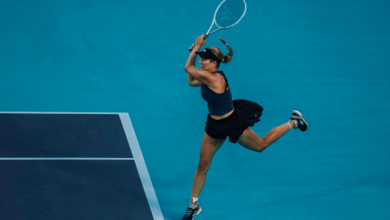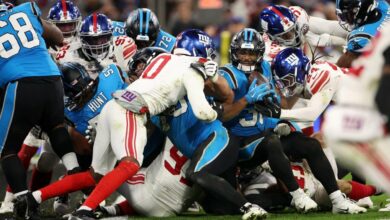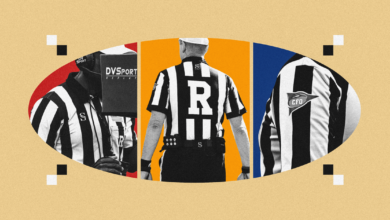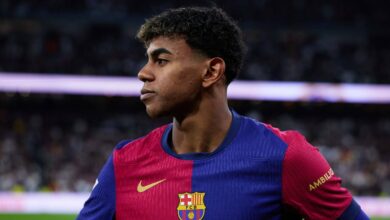Frances Tiafoe reaches US Open semifinals against Taylor Fritz
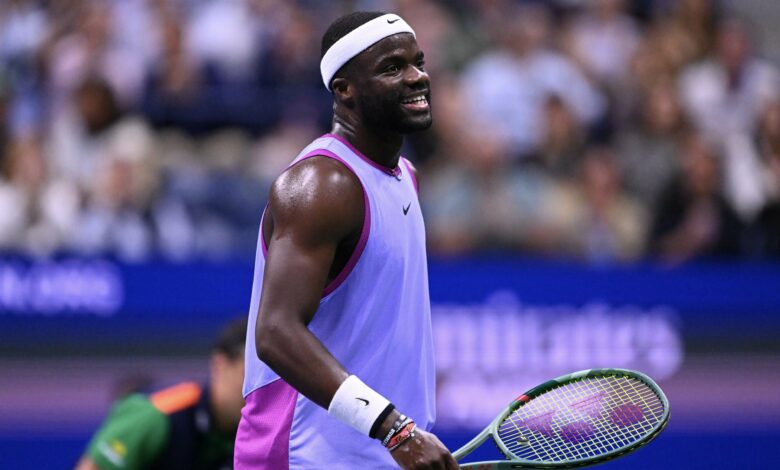
NEW YORK — There are nights when Frances Tiafoe transforms Arthur Ashe Stadium into a swinging party.
His house. His music blasting from the speakers. Nearly 24,000 friends, cousins, kings, queens, stars of the silver screen and hardwood, and of course an all-time tennis great or half a dozen. They all bounce to his beat and shake every level of the grand tennis court at Flushing Bay.
Tuesday night at Ashe was different. No better or worse, especially with Tiafoe rolling into the first all-American US Open semifinal since 2005, when Andre Agassi defeated Robby Ginepri. The same party crowd filled nearly every seat, high and low, from the sidelines to the very top of the roof. Kevin Hart, Jason Sudeikis, Roger Federer, Sabrina Ionescu and a host of other A-listers passed by. It was the quiet lurch toward the pounding night that morphs into morning, smooth jazz and R&B humming through the speakers; glasses clinking with expensive bubbly.
But the end of the night, and the 6-3, 6-7(5), 6-3, 4-1 victory that ended with an asterisk above a handicapped Grigor Dimitrov? It wasn’t the atmosphere. It wasn’t the walk-off that Tiafoe, or his 24,000 friends, had in mind.
The stadium was already murmuring when Dimitrov double-faulted to end the third set. That was not unusual, after the three double-faults — two for Dimitrov, one for Tiafoe — that decided the second set in the Bulgarian’s favor.
As he sat down, Dimitrov grabbed his leg and gestured to his team, his hand slashing at the night air as if to say, “This is it.” He looked up and smiled sadly, barely able to believe that this was happening to him, right here, right now.
He limped off the court. He limped back. Tiafoe served his first game of the fourth set to love. Dimitrov delivered an 84 mph first serve as he tried to continue what had been two hours and forty-five minutes of strange, exhausting tennis.

Grigor Dimitrov took the lead at the end of the third set. (Charly Triballeau / AFP via Getty Images)
It got weirder.
Tiafoe did what players often do when an opponent is struggling physically. He hit balls straight at Dimitrov, unable to turn off the pattern-play switch in his brain and move him across the court. Then he figured it out. He dragged Dimitrov to the backhand corner and formed one of those whipped, arcing cross-court forehands he’s so good at hitting short and wide. Dimitrov didn’t even move.
Tiafoe took a 2-0 lead. Dimitrov remained on the field.
At 15-0 Tiafoe, Dimitrov clapped his racket toward his box, as if asking for appreciation for remaining there, a defeated man limping. Tiafoe served a double fault at 40-0. He won the match anyway. The air had gone from the stadium. This was not how it was supposed to be.
At 4-1, they embraced at the net and Tiafoe was where he wanted to be. The same place he was two years ago, ready to face Carlos Alcaraz and start a new house party.
The whole night passed differently. There were also a few moments of rising energy, like that celebratory sprint across the baseline, racket raised high after another Dimitrov forehand into the net that clinched the first set for Tiafoe. Or when Dimitrov forced his way to an even score after a service break down in the second set, with a few deft stab volleys and wrist flicks that have always earned him those style points.
A few games later, Dimitrov’s legs gave out and the consequences of a painful five-set, fourth-round victory on a sweaty Sunday hit hard. So when it was over, for the guy who throws parties like no other these days, it was a relaxing evening. No broken furniture. Everyone gets home safely and saves themselves for what’s coming in the weekend.

Frances Tiafoe considers the US Open like no other tournament. (Charly Triballeau / AFP via Getty Images)
“I’m going to have to be more aggressive,” Tiafoe said on the court. “At the end of the day, man, I’m going to have to dig, dig, dig.
“US Open semi-final, no excuses.”
For American men’s tennis, these are the best days in years. Here’s what you need to know and why.
The All-American semi-final
Tiafoe’s victory over Dimitrov means he will face his early teenage buddy Taylor Fritz in the semi-finals, who defeated Germany’s Alexander Zverev in four sets on Tuesday afternoon.
Fritz and “Big Foe,” as everyone calls Tiafoe, started hitting balls at national camps twelve years ago. Tiafoe and their other friend, Tommy Paul, were much better than Fritz back then. Fritz has flipped the script in the last three years and mostly holds the title of American No. 1, even though Tiafoe is the bigger star.
The drought in American men’s tennis
Once upon a time, Americans ruled men’s tennis. But the world got bigger after the Iron Curtain fell. America’s reliance on its wealth and population to automatically produce the best players in the world proved to be its Achilles heel.
The USTA was slow to realize this. In the late 2000s, Andy Roddick was nearing the end of his career. The last American world number 1 and the last American man to win the US Open (in 2003) had no great talent behind him.
Tiafoe and Fritz were among the first players the federation turned to when it began a decades-long plan to develop players who could compete with the best. It ended up taking longer than that, with Fritz and his compatriots being beaten by Roger Federer, Rafael Nadal and Novak Djokovic, as well as a host of better, more consistent players from Europe, over the past seven years. Then came Carlos Alcaraz and Jannik Sinner, and they started beating them, too.
They have to beat each other on Friday.

Andy Roddick lifts the trophy in 2003. (Chuck Solomon/Sports Illustrated via Getty Images)
The Story of Tiafoe’s Rise and Fall
Tiafoe has been missing for the past year, since his quarterfinal loss to Ben Shelton here 364 days ago. He thought he was destined for the semifinals and beyond. Shelton stole his lunch, grabbed the spotlight and sent Tiafoe into a tailspin.
Since then, he has lost as much as he wins, and has struggled to find motivation. Then in July, he played his way to a third-round showdown with Carlos Alcaraz on Centre Court at Wimbledon.

GALLING DEEPER
‘Better tennis is on the horizon’: Will Frances Tiafoe come back to life?
He had never played in the cathedral of the sport before and came within a handful of points of eliminating the eventual champion. The crowd cheered him like they hadn’t in a long time. It reminded him why he plays this game and inspired him to push for a big run at the US Open.
“If I play well, it definitely helps the sport,” Tiafoe said.
When he saw the draw, he couldn’t look past “Ben,” his friend Shelton. Then he beat him. Then Djokovic went out.
“The draw shakes,” he said. “And then you think, why not?”
The match-up
Fritz has a big advantage. He is 6-1 in their head-to-head. Tiafoe hasn’t beaten him since 2016, long before Fritz was the player he is today.
They have only played each other once in a Grand Slam, at the 2022 Australian Open, when Tiafoe tried to fight his way out of a slump and started his ascent, culminating in a five-set win over Carlos Alcaraz.
Tiafoe has the edge in speed, movement and creativity. He has more strokes in his racket than Fritz. But Fritz has the two best strokes: his serve and his forehand.
“When I first met him, he was a strange cat,” Tiafoe said of Fritz. “When we all turned pro, we pushed each other to be great. Nobody wants to leave each other behind.”
Are you going all out?
Two American men in the semifinals means one will reach the final. Fritz or Tiafoe will likely have to beat Jannik Sinner, the world No. 1, or Daniil Medvedev, a six-time Grand Slam finalist and the 2021 US Open champion. There hasn’t been an American man in a major final since 2009, when Roddick lost 16-14 in the fifth set to Federer, shadows slanting across the Wimbledon grass.
Medvedev and Sinner will play each other in their quarterfinal on Wednesday. The other quarterfinal is between Alex de Minaur from Australia and the Brit Jack Draper.
(Fatih Aktas/Anadolu via Getty Images)

